The Flower of Edo (Sukeroku Yukari no Edozakura)
Painted by Utagawa Kunisada I 1832 (Tempō 3) Tokyo Shiryō Collection M239-4-3
This work depicts the scene of "The Flower of Edo (Sukeroku Yukari no Edozakura)", one of the series Eighteen Great Kabuki Plays. The popular actors such as Matsumoto Kōshirō, Ichikawa Ebizō and Iwai Hanshirō, whose names have been passed down until today, played the roles in this play.
Sukeroku is said to have been performed for the first time in 1713 (Shōtoku 3) when Ichikawa Danjūrō II played the role in "Sakura(Cherry Blossoms) Beloved of the Great Houses (Hanayakata Aigo no Sakura(cherry blossom))" performed by the Edo Yamamuraza troupe. The play continued to be refined by the great actors and finally became one of the Kabuki-Jūhachiban (Ichikawa Danjūrō family collection of best plays) in 1832 (Tenpō 3). At this time, Danjūrō VII passed down his professional name to Danjūrō VIII and took on his former name again, Ichikawa Ebizō V.
n this scene, Otokodate Hanakawado Sukeroku, actually Soga Gorō, goes in and out of the Yoshiwara (licensed prostitution quarters in Edo) to investigate the treasure sword and repeatedly had a fight with brothel customers to make them draw a sword. The ink used for the letters of Matsumoto Kōshirō, who played Ikyū, is thick, and the inlaid wood marks can be found around his face. In addition, Kōshirō wears a costume with Hanakatsumi pattern, which symbolizes the Bandō family. It is assumed that Bandō Mitsugorō III was scheduled to perform the role of Ikyū and the block had been completed, but it was suddenly decided that Kōshirō play the role, and only the face was replaced.


